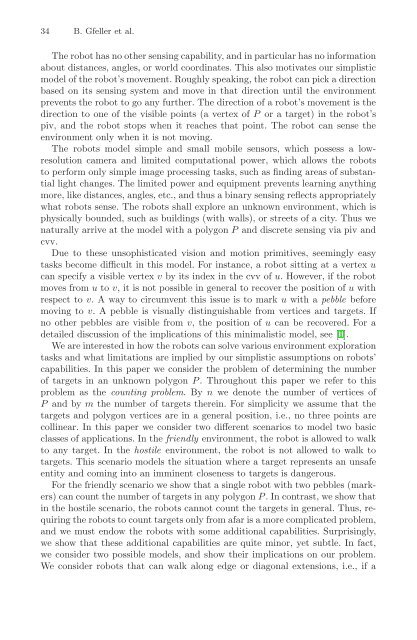Lecture Notes in Computer Science 4837
Lecture Notes in Computer Science 4837
Lecture Notes in Computer Science 4837
You also want an ePaper? Increase the reach of your titles
YUMPU automatically turns print PDFs into web optimized ePapers that Google loves.
34 B. Gfeller et al.<br />
The robot has no other sens<strong>in</strong>g capability, and <strong>in</strong> particular has no <strong>in</strong>formation<br />
about distances, angles, or world coord<strong>in</strong>ates. This also motivates our simplistic<br />
model of the robot’s movement. Roughly speak<strong>in</strong>g, the robot can pick a direction<br />
based on its sens<strong>in</strong>g system and move <strong>in</strong> that direction until the environment<br />
prevents the robot to go any further. The direction of a robot’s movement is the<br />
direction to one of the visible po<strong>in</strong>ts (a vertex of P or a target) <strong>in</strong> the robot’s<br />
piv, and the robot stops when it reaches that po<strong>in</strong>t. The robot can sense the<br />
environment only when it is not mov<strong>in</strong>g.<br />
The robots model simple and small mobile sensors, which possess a lowresolution<br />
camera and limited computational power, which allows the robots<br />
to perform only simple image process<strong>in</strong>g tasks, such as f<strong>in</strong>d<strong>in</strong>g areas of substantial<br />
light changes. The limited power and equipment prevents learn<strong>in</strong>g anyth<strong>in</strong>g<br />
more, like distances, angles, etc., and thus a b<strong>in</strong>ary sens<strong>in</strong>g reflects appropriately<br />
what robots sense. The robots shall explore an unknown environment, which is<br />
physically bounded, such as build<strong>in</strong>gs (with walls), or streets of a city. Thus we<br />
naturally arrive at the model with a polygon P and discrete sens<strong>in</strong>g via piv and<br />
cvv.<br />
Due to these unsophisticated vision and motion primitives, seem<strong>in</strong>gly easy<br />
tasks become difficult <strong>in</strong> this model. For <strong>in</strong>stance, a robot sitt<strong>in</strong>g at a vertex u<br />
can specify a visible vertex v by its <strong>in</strong>dex <strong>in</strong> the cvv of u. However, if the robot<br />
moves from u to v, it is not possible <strong>in</strong> general to recover the position of u with<br />
respect to v. A way to circumvent this issue is to mark u with a pebble before<br />
mov<strong>in</strong>g to v. A pebble is visually dist<strong>in</strong>guishable from vertices and targets. If<br />
no other pebbles are visible from v, the position of u can be recovered. For a<br />
detailed discussion of the implications of this m<strong>in</strong>imalistic model, see [1].<br />
We are <strong>in</strong>terested <strong>in</strong> how the robots can solve various environment exploration<br />
tasks and what limitations are implied by our simplistic assumptions on robots’<br />
capabilities. In this paper we consider the problem of determ<strong>in</strong><strong>in</strong>g the number<br />
of targets <strong>in</strong> an unknown polygon P . Throughout this paper we refer to this<br />
problem as the count<strong>in</strong>g problem. Byn we denote the number of vertices of<br />
P and by m the number of targets there<strong>in</strong>. For simplicity we assume that the<br />
targets and polygon vertices are <strong>in</strong> a general position, i.e., no three po<strong>in</strong>ts are<br />
coll<strong>in</strong>ear. In this paper we consider two different scenarios to model two basic<br />
classes of applications. In the friendly environment, the robot is allowed to walk<br />
to any target. In the hostile environment, the robot is not allowed to walk to<br />
targets. This scenario models the situation where a target represents an unsafe<br />
entity and com<strong>in</strong>g <strong>in</strong>to an imm<strong>in</strong>ent closeness to targets is dangerous.<br />
For the friendly scenario we show that a s<strong>in</strong>gle robot with two pebbles (markers)<br />
can count the number of targets <strong>in</strong> any polygon P . In contrast, we show that<br />
<strong>in</strong> the hostile scenario, the robots cannot count the targets <strong>in</strong> general. Thus, requir<strong>in</strong>g<br />
the robots to count targets only from afar is a more complicated problem,<br />
and we must endow the robots with some additional capabilities. Surpris<strong>in</strong>gly,<br />
we show that these additional capabilities are quite m<strong>in</strong>or, yet subtle. In fact,<br />
we consider two possible models, and show their implications on our problem.<br />
We consider robots that can walk along edge or diagonal extensions, i.e., if a
















